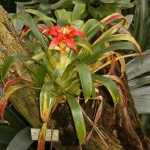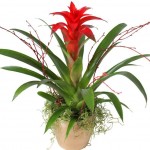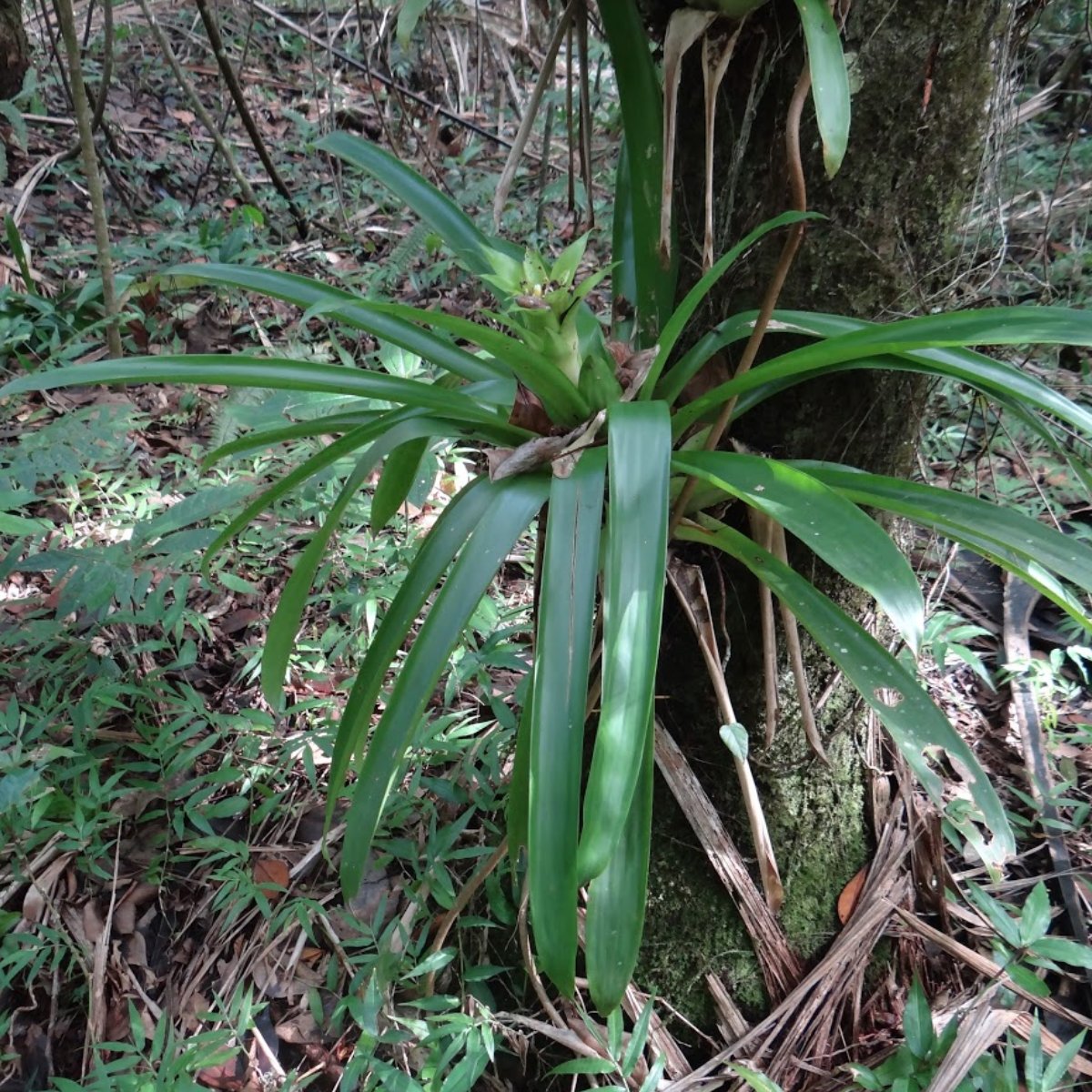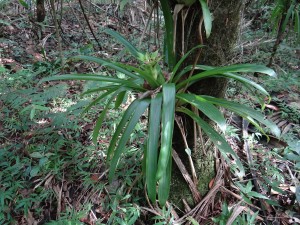Family: Bromeliaceae
Synonyoums: Guzmania peacockii
Nidularium splendens
Tillandsia clavata
Tillandsia lingulata
Distribution and habitat: Guzmania lingulata is an evergreen perennial plant, native to tropical wet and humid forest from Central and South America. Some of Guzmania lingulata grow terrestrially, but most of them are epiphyte in their natural habitat, growing on trees and rocks. These epiphytes do not cause any damage to their host, as their roots act primarily as an anchor rather than an organ which extract water and nutrients from the host.
Guzmania lingulataonly bloom a single time. As the plants grow by adding new leaves from the center, it becomes impossible to continue growth after flowering since the inflorescence blocks new leaf growth. The plants direct their energy into growing new vegetative offsets (pups) from growing buds at the base of the leaves.
Description: Guzmania lingulata is a quite a variable species; individual specimens differ considerably in some respects. Characteristic of the species are smooth green leaves 45cm (18 inch) long and 2cm (0.8 inch) wide, with a flower stalk up to 30cm (12 inch) long bearing small yellow flowers in the centre of a cup-shaped or funnel-shaped flower head of 4cm (1.5 inch) long crimson bracts.
The leaves come together to form a star shape in the middle. Perhaps Guzmania lingulata is most famous for its brilliant pink or red flower bracts, but also can be found in shades of yellow and orange depending on the variety. What appears to be the flower on the plant is actually a grouping of modified leaves, called bracts. They are green at the beginning and little by little they start to colour in bright colours depending on their variety. These bracts can last for about 5 months. The true flowers do not rise above the bracts, having a brief couple of days blooming period. Once the true flowering has taken place, the plant begin to wither and dies, but before dying it will produce offsets that grow at the base of the plant. Guzmania lingulata reaches its maturity in about 3 or 4 years, period of time after that it will to be able to flower.
Guzmania lingulatagrows about 30cm (12 inch) high and 45cm (18 inch) wide.
Houseplant care: Cut away spent inflorescence to look tidy and divert the plants energy to producing more plantlets. If necessary, trim back the leaves of the parent plant to allow freer growth of their pups.
Light: Guzmania lingulata like bright filtered light. They will not flower if they are too far from a window.
Temperature: Give these plants temperatures above 18C (64F) with high humidity. Stand the pots on trays of damp pebbles and mist-spray the foliage every day.
Be especially careful during the winter not to letGuzmania lingulata become too cold and dry. To increase humidity place the Guzmania lingulata near other plants or in parts of the house that are naturally more humid such as the bathroom or kitchen.
Water: Water moderately and mist regularly in summer. Outside the flowering period the rosette should be kept filled with water. Change water every 3 to 4 weeks to keep it from rotting. Use soft water.
Never put water in the bracts or flowering portion of the plant. It will shorten the life of the flower.
Fertilising: Apply standard liquid fertiliser every two weeks not only to the potting mixture but over the foliage and into the central cup.
Potting and repotting: Use the potting mixture recommended for bromeliads. Since these plants have little root, 7-10cm (3-4 inch) pots should be large enough. If a plant needs more room, move it into a pot at least one size larger in spring.
Note that Guzmania lingulata are usually top heavy, so be sure to anchor the pot well with heavy rock on the bottom or use a heavy pot.
Bark Mounted: Because they are epiphytes, Guzmania lingulata do not require soil to grow and sometimes is refereed as a air plant. When cultivated as an epiphyte the plants are mounted on a piece of bark or a branch (e.g. Taxus or Thuja) and the roots are wrapped in Sphagnum moss. When grown as an epiphyte misting daily usually is sufficient. Use soft water and mist the plant in the early morning if it possible. Keep the center of the plant filled with water. Empty the center or cup of the plant every couple of weeks and replace the old, stale water with fresh water.
Keep the plant barely moist (no misting) in winter.
Garden Culture: Guzmania lingulata prefer a sunny to half-shady situation on peat and sand moist soil. They are hardy to hardiness zone 10. In summer the plants prefer protection from hot midday sun. Water regularly. Keep the center of the plant filled with water but allow the soil to dry out between each wetting. Their centers are kept full of water. They grow best in high humidity but tolerate drier air. Do not overwater them. Fertilizing helps them grow bigger, mature faster, and produce larger inflorescences.
Propagation: In spring cut offsets from the parent, but not before the offsets are 8cm (3 inch) long. Insert each offset in a 5-6cm (2-2.5 inch) pot of bromeliads mixture, keep it bright filtered light and water it moderately. When the offset is well rooted (in about six months) move it into a pot one size larger and treat it as a mature Guzmania lingulata.
These plantlets mature and bloom within a few years.
Problems:
Brown patches on the leaves may be caused by direct exposure to sun.
Brown tips on the leaves usually indicate insufficient humidity in the air.
In their natural habitat, most Guzmania plants grow on the branches of other trees, not in soil, and they are prone to root rot.
The main pests of this bromeliads are scale and mealy bugs. Scale will look like little round dots covering the top or bottom of the leaves. Mealy bug will look like a white cottony patch.
Treatment: For small outbreaks, these can both be treated by wiping over them with a cotton swab dipped in rubbing alcohol. For more wide spread infestations, try mixing a little mild dishwashing detergent or baby shampoo with water and spraying the infected plants. The soap will coat and suffocate the insects. It is recommended to rinse the plants off with clean water to make sure the pores on the leaves are open so the plant can breathe. DO NOT use heavy oil based insecticides as these are likely to choke the plant as well.
Notes: Bromeliads can be forced to flower by exposing it to ethylene gas that can be emitted from a ripen apple. Place the plant inside a clear plastic bag with a ripe apple for two to three days. Depending on the type of plant, flowering will begin in six to fourteen weeks.
Recommended varieties:
Guzmania lingulata cardinalis is a little larger than the species plant and has bracts of an even stronger red.
Guzmania lingulata minor is growing less than 30cm (12 inch) tall and has leaves only about 10cm (4 inch) long and a cup-shaped flower head on a short, stumpy stem carrying variably coloured bracts.
Availability: Guzmania lingulata is usually sold at the beginning of its flowing period in mid summer to early fall and the flower will last for many months.
Uses: Guzmania lingulata are used very successfully in indoor commercial situations such as shopping malls and office buildings. They add dazzling color and a tropical feel to any room. Get one for the office, too, and make a bold statement. It grows well under the fluorescent light of offices and is wonderfully stunning tabletop plant..
Grown outdoors, it will be most ideal in front-of-the-border grouping in garden beds or borders, as well as a landscaping plant for rock gardens.
Guzmania lingulata can be grown for cut flowers, used in live floral arrangements or to enliven shaded patios and gardens during the warmer months. It can be grown as an epiphyte mounted on a piece of bark or a branch.
SUMMARY:
CHARACTERISTICS:
Foliage green
Features - flowers
Shape rosette
Height: 30-45cm (12-18 inch)
Spacing: 38-45 cm (15-18 inch)
PROPER CARE:
Watering in active growth period plentifully
Light bright filtered
Temperature in active growth period min 18C max 27C (64-81F)
Humidity high
Hardiness zone: 10a-11





